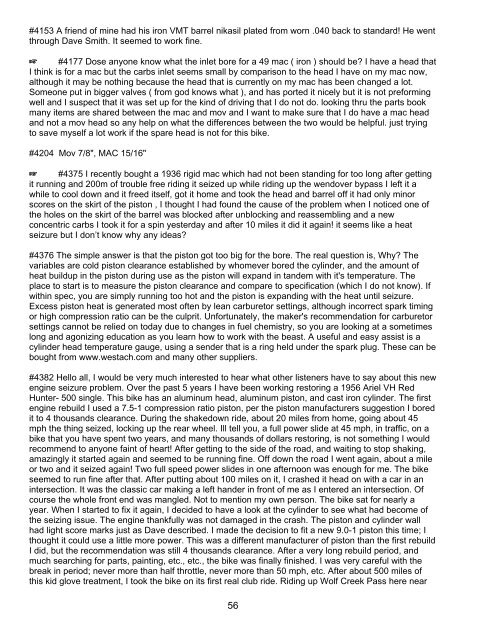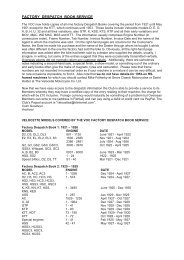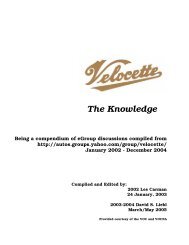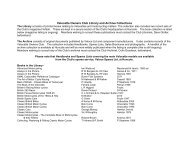The Knowledge - Velocette Owners Club
The Knowledge - Velocette Owners Club
The Knowledge - Velocette Owners Club
You also want an ePaper? Increase the reach of your titles
YUMPU automatically turns print PDFs into web optimized ePapers that Google loves.
#4153 A friend of mine had his iron VMT barrel nikasil plated from worn .040 back to standard! He went<br />
through Dave Smith. It seemed to work fine.<br />
L #4177 Dose anyone know what the inlet bore for a 49 mac ( iron ) should be? I have a head that<br />
I think is for a mac but the carbs inlet seems small by comparison to the head I have on my mac now,<br />
although it may be nothing because the head that is currently on my mac has been changed a lot.<br />
Someone put in bigger valves ( from god knows what ), and has ported it nicely but it is not preforming<br />
well and I suspect that it was set up for the kind of driving that I do not do. looking thru the parts book<br />
many items are shared between the mac and mov and I want to make sure that I do have a mac head<br />
and not a mov head so any help on what the differences between the two would be helpful. just trying<br />
to save myself a lot work if the spare head is not for this bike.<br />
#4204 Mov 7/8", MAC 15/16"<br />
L #4375 I recently bought a 1936 rigid mac which had not been standing for too long after getting<br />
it running and 200m of trouble free riding it seized up while riding up the wendover bypass I left it a<br />
while to cool down and it freed itself, got it home and took the head and barrel off it had only minor<br />
scores on the skirt of the piston , I thought I had found the cause of the problem when I noticed one of<br />
the holes on the skirt of the barrel was blocked after unblocking and reassembling and a new<br />
concentric carbs I took it for a spin yesterday and after 10 miles it did it again! it seems like a heat<br />
seizure but I don’t know why any ideas?<br />
#4376 <strong>The</strong> simple answer is that the piston got too big for the bore. <strong>The</strong> real question is, Why? <strong>The</strong><br />
variables are cold piston clearance established by whomever bored the cylinder, and the amount of<br />
heat buildup in the piston during use as the piston will expand in tandem with it's temperature. <strong>The</strong><br />
place to start is to measure the piston clearance and compare to specification (which I do not know). If<br />
within spec, you are simply running too hot and the piston is expanding with the heat until seizure.<br />
Excess piston heat is generated most often by lean carburetor settings, although incorrect spark timing<br />
or high compression ratio can be the culprit. Unfortunately, the maker's recommendation for carburetor<br />
settings cannot be relied on today due to changes in fuel chemistry, so you are looking at a sometimes<br />
long and agonizing education as you learn how to work with the beast. A useful and easy assist is a<br />
cylinder head temperature gauge, using a sender that is a ring held under the spark plug. <strong>The</strong>se can be<br />
bought from www.westach.com and many other suppliers.<br />
#4382 Hello all, I would be very much interested to hear what other listeners have to say about this new<br />
engine seizure problem. Over the past 5 years I have been working restoring a 1956 Ariel VH Red<br />
Hunter- 500 single. This bike has an aluminum head, aluminum piston, and cast iron cylinder. <strong>The</strong> first<br />
engine rebuild I used a 7.5-1 compression ratio piston, per the piston manufacturers suggestion I bored<br />
it to 4 thousands clearance. During the shakedown ride, about 20 miles from home, going about 45<br />
mph the thing seized, locking up the rear wheel. Ill tell you, a full power slide at 45 mph, in traffic, on a<br />
bike that you have spent two years, and many thousands of dollars restoring, is not something I would<br />
recommend to anyone faint of heart! After getting to the side of the road, and waiting to stop shaking,<br />
amazingly it started again and seemed to be running fine. Off down the road I went again, about a mile<br />
or two and it seized again! Two full speed power slides in one afternoon was enough for me. <strong>The</strong> bike<br />
seemed to run fine after that. After putting about 100 miles on it, I crashed it head on with a car in an<br />
intersection. It was the classic car making a left hander in front of me as I entered an intersection. Of<br />
course the whole front end was mangled. Not to mention my own person. <strong>The</strong> bike sat for nearly a<br />
year. When I started to fix it again, I decided to have a look at the cylinder to see what had become of<br />
the seizing issue. <strong>The</strong> engine thankfully was not damaged in the crash. <strong>The</strong> piston and cylinder wall<br />
had light score marks just as Dave described. I made the decision to fit a new 9.0-1 piston this time; I<br />
thought it could use a little more power. This was a different manufacturer of piston than the first rebuild<br />
I did, but the recommendation was still 4 thousands clearance. After a very long rebuild period, and<br />
much searching for parts, painting, etc., etc., the bike was finally finished. I was very careful with the<br />
break in period; never more than half throttle, never more than 50 mph, etc. After about 500 miles of<br />
this kid glove treatment, I took the bike on its first real club ride. Riding up Wolf Creek Pass here near<br />
56





